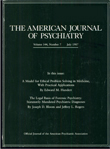Emotional activation of limbic circuitry in elderly normal subjects in a PET study
Abstract
OBJECTIVE: This study was undertaken to identify brain structures associated with emotion in normal elderly subjects. METHOD: Eight normal subjects aged 55-78 years were shown film clips intended to provoke the emotions of happiness, fear, or disgust as well as a neutral state. During emotional activation, regional cerebral blood flow was measured with the use of [15O]H2O positron emission tomography imaging, and subjective emotional responses were recorded. Data were analyzed by subtracting the values during the neutral condition from the values in the various emotional activations. RESULTS: The stimuli produced a general activation in visual pathways that included the primary and secondary visual cortex, involving regions associated with object and spatial recognition. In addition, the specific emotions produced different regional limbic activations, which suggests that different pathways may be used for different types of emotional stimuli. CONCLUSIONS: Emotional activation in normal elderly subjects was associated with increases in blood flow in limbic and paralimbic brain structures. Brain activation may be specific to the emotion being elicited but probably involves complex sensory, association, and memory circuitry. Further studies are needed to identify activations that are specific for emotion.



